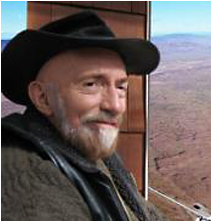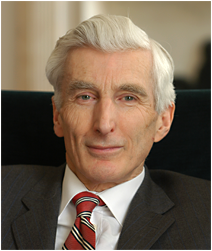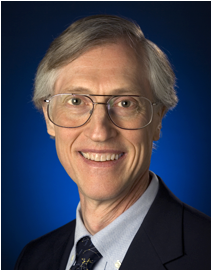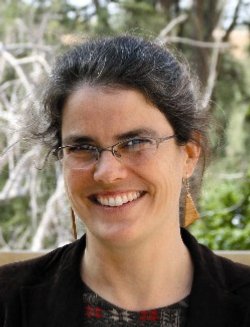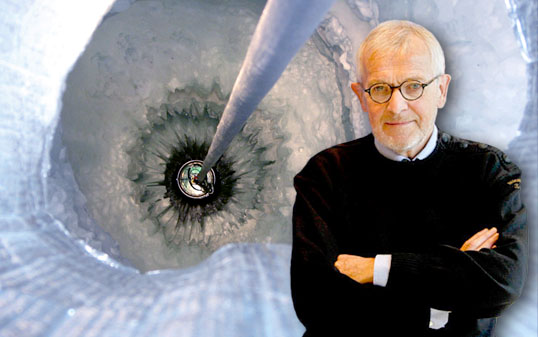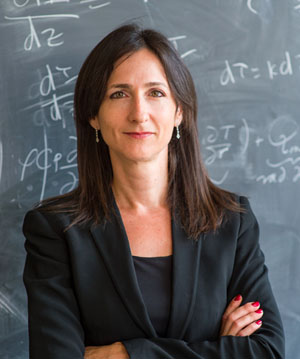 |
 |
 |
 |
 |
 |
 |
 |
 |
 |
 |
 |
|
Talks & Events
|
Astronomy Brinson Lectures The Brinson Lecture is held every spring to present cutting-edge science in an event that is free and open to the public. These lectures are made possible by a generous gift from the Brinson Foundation to the University of Chicago. Wendy Freedman, Carnegie Observatories, "Astronomy in the New Millennium: New Windows on the Cosmos" Wendy L. Freedman, Carnegie Observatories Wendy L. Freedman, the Director of the Carnegie Observatories, grew up in Toronto, Canada, and received her BSc (1979), MS (1980), and PhD (1984) in astronomy and astrophysics from the University of Toronto. Her early work focused on the formation of stars, and the study of Cepheids, extremely bright stars whose fluctuating luminosity can be used to accurately determine distances between objects in space. This work led to her leadership role with the Hubble Space Telescope Key Project on the Extragalactic Distance Scale, which used Cepheid stars to measure the rate of the universe's expansion. In 1984, Freedman joined the Observatories of the Carnegie Institution in Pasadena, California, as a postdoctoral fellow. Three years later, she became a faculty member there - the first woman to join the Observatories' permanent scientific staff. In March 2003, she was named the Crawford H. Greenewalt Chair and Director of the Carnegie Observatories. Freedman has received many honors for her studies of galactic evolution and the evolution of stellar populations of galaxies, as well as for her leadership in bringing observational cosmology into the 21st century. These awards include the American Philosophical Society's Magellanic Premium Award (2002), the Royal Astronomical Society's George Darwin Lectureship (2001), and the Cosmos Club Foundation's John P. McGovern Award in Science (2000). She was elected to the American Academy of Arts and Sciences in 2000, the National Academy of Sciences in 2003 and to the American Philosophical Society in 2007. 2008-2009 Brinson Lecture: "Astronomy in the New Millennium: New Windows on the Cosmos" Join Dr. Freedman, the inaugural Brinson Lecturer at The University of Chicago, for an exciting evening exploring the forefronts of astronomy, as we prepare to mark the 400th anniversary of when Galileo Galilei first turned a telescope to the sky. In the last few decades alone, we have discovered about 300 new planets outside of those in our own Solar System, detected massive black holes, and observed the entire universe to be expanding at an increasing rate, pulled apart by a cosmic force, unexplained by any of our current physical theories. Dr. Freedman will focus on recent astronomical discoveries, and show how giant new telescopes planned for both the ground and space will address some of the biggest mysteries in astronomy today. Kip S. Thorne, California Institute of Technology, "The Warped Side of the Universe: From the Big Bang to Black Holes" Website Kip S. Thorne, California Institute of Technology Born in Logan Utah in 1940, Kip Thorne received his B.S. degree from Caltech in 1962 and his Ph.D. from Princeton University in 1965. He returned to Caltech as an Associate professor in 1967 and became Professor of Theoretical Physics in 1970, The William R. Kenan, Jr., Professor in 1981, The Feynman Professor of Theoretical Physics in 1991, and The Feynman Professor of Theoretical Physics, Emeritus, in 2009. Thorne's research has focused on Einstein's general theory of relativity and on astrophysics, with emphasis on relativistic stars, black holes and especially gravitational waves. He was cofounder (with R. Weiss and R.W.P. Drever) of the LIGO (Laser Interferometer Gravitational Wave Observatory) Project, with which he is still associated. He is a member of the LISA (Laser Interferometer Space Antenna) International Science Team. Thorne was elected to the American Academy of Arts and Sciences in 1972, the National Academy of Sciences in 1973, and the Russian Academy of Sciences and the American Philosophical Society in 1999. He has been awarded the Lilienfeld Prize of the American Physical Society, the Karl Schwarzschild Medal of the German Astronomical Society, the Albert Einstein Medal of the Albert Einstein Society in Berne, Switzerland, the UNESCO Niels Bohr Gold Medal from UNESCO, and the Common Wealth Award for Science, and was named California Scientist of the Year in 2004. For his book for nonscientists, Black Holes and Time Warps: Einstein's Outrageous Legacy (Norton Publishers 1994), Thorne was awarded the American Institute of Physics Science Writing Award, the Phi Beta Kappa Science Writing Award, and the (Russian) Priroda Readers' Choice Award. In 1973 Thorne coauthored the textbook Gravitation, from which most of the present generation of scientists have learned general relativity theory. Fifty-two physicists have received the PhD at Caltech under Thorne's personal mentorship. 2009-2010 Brinson Lecture: "The Warped Side of the Universe: From the Big Bang to Black Holes" Our Universe has a "warped side" -- objects and phenomena, like black holes and the big-bang, that are made not from matter, but rather from warped space and warped time. Thorne will describe this mysterious warped side and the quest to simulate it using supercomputers and observe it using gravitational waves. This event is co-sponsored by the University of Chicago and the Adler Planetarium. Martin Rees, Astronomer Royal, "From Big Bang to Biospheres" Website Martin Rees, Astronomer Royal The Martin Rees lecture audio (WBEZ) Martin Rees is Master of Trinity College, Cambridge and holds the honorary title of Astronomer Royal. He was previously Director of the Institute of Astronomy at Cambridge, and has lectured widely in the US, Europe and the Far East. His research interests include cosmology, galaxy formation, black holes and 'high energy' phenomena in the universe As well as his research publications, he is the author of eight books, and numerous articles on scientific and general subjects. He is a foreign associate of the US National Academy of Sciences, the Russian Academy of Sciences, the Pontifical Academy, and several other foreign academies. He is a member of the UK's House of Lords, and recently completed a five-year term as President of the Royal Society (the UK's national science academy). 2010-2011 Brinson Lecture: "From Big Bang to Biospheres" Moderated by Gabriel Spitzer, WBEZ Astronomers have made astonishing progress in probing our cosmic environment, thanks to advanced technology. We can trace cosmic history back to some mysterious 'beginning' nearly 14 billion years ago, and understand in outline the emergence of atoms, galaxies, stars and planets -- and how, on at least one planet, life developed a complex biosphere of which we are part. But these advances pose new questions: What does the long-range future hold? How widespread is life in our cosmos? Should we be surprised that the physical laws permitted the emergence of complexity? and Is physical reality even more extensive than the domain that our telescopes can probe? This illustrated lecture will address (but not answer!) such questions. This event is co-sponsored by the University of Chicago and the School of the Art Institute of Chicago. This event is made possible by a generous gift from the Brinson Foundation to the University of Chicago. 2011-2012 Brinson Lecture: John Mather, Nobel laureate, "History of the universe in a nutshell: from the Big Bang to life and the end of time" Website John C. Mather, 2011-2012 Brinson Lecturer John C. Mather is an astrophysicist, cosmologist and Nobel laureate. He was awarded the 2006 Nobel Prize in Physics for his work on the Cosmic Background Explorer Satellite (COBE). Mather received his Nobel Prize for the precise determination that the spectrum of the cosmic microwave background radiation is that of a thermal source and the first detection and measurement of the anisotropy. These measurements marked the beginning of the era of precision cosmology. Mather is currently a Senior Astrophysicist at the U.S. space agency's (NASA) Goddard Space Flight Center in Maryland and the Senior Project Scientist for the James Webb Space Telescope, the successor to the Hubble Space Telescope. 2011-2012 Brinson Lecture: "History of the universe in a nutshell: from the Big Bang to life and the end of time" The history of the universe in a nutshell, from the Big Bang to now, and on to the future - John Mather will tell the story of how we got here, how the Universe began with a Big Bang, how it could have produced an Earth where sentient beings can live, and how those beings are discovering their history. Mather was Project Scientist for NASA's Cosmic Background Explorer (COBE) satellite, which measured the spectrum (the color) of the heat radiation from the Big Bang, discovered hot and cold spots in that radiation, and hunted for the first objects that formed after the great explosion. He will explain Einstein's biggest mistake, how Edwin Hubble discovered the expansion of the universe, how the COBE mission was built, and how the COBE data support the Big Bang theory. He will also show NASA's plans for the next great telescope in space, the James Webb Space Telescope. It will look even farther back in time than the Hubble Space Telescope, and will peer inside the dusty cocoons where stars and planets are being born today. It is capable of examining Earth-like planets around other stars using the transit technique, and future missions may find signs of life. This event is co-sponsored by the University of Chicago and the School of the Art Institute of Chicago. 2012 Brinson Lecture: David Charbonneau, "The Fast Track to Find an Inhabited Exoplanet" Website David Charbonneau, 2012 Brinson Lecturer David Charbonneau is a professor of astronomy at Harvard University. He led the first studies of the compositions of exoplanets and of their atmospheres, and he is a member of the NASA Kepler Mission to find Earth-like planets. Dr. Charbonneau has received numerous awards for his research, including the NASA Medal for Exceptional Scientific Achievement, and he was named Scientist of the Year by Discover Magazine. 2012 Brinson Lecture: "The Fast Track to Find an Inhabited Exoplanet" Are there inhabited worlds other than our own? Although humans have pondered this for generations, this is the first time that we have the technological ability to answer it. In the past year astronomers have found the first Earth-sized worlds orbiting other Suns, and the first exoplanets with the right temperature for liquid water. If we can study the atmospheres of such planets, we can search for the telltale molecular fingerprints of life. This event is co-sponsored by the University of Chicago and the Adler Planetarium & Astronomy Museum. 2013 Brinson Lecture: Andrea M. Ghez, "The Monster at the Heart of the Milky Way" Website Andrea M. Ghez, 2013 Brinson Lecturer Andrea M. Ghez, a professor of Physics & Astronomy who holds the Lauren B. Leichtman & Arthur E. Levine chair in Astrophysics, is one of the world's leading experts in observational astrophysics and heads UCLA's Galactic Center Group. She earned her B.S in Physics from MIT in 1987, and her PhD from Caltech in 1992 and has been on the faculty at UCLA since 1994. Best known for her ground-breaking work on the center of our Galaxy, which has led to the best evidence to date for the existence of supermassive black holes, she has received numerous honors and awards including the Crafoord Prize in Astronomy (she is the first woman to receive a Crafoord prize in any field), a MacArthur Fellowship, and election to the National Academy of Sciences, the American Academy of Arts & Sciences, and the American Philosophical Society. Her work can be found in many public outlets including TED, NOVA's Monster of the Milky Way, Discovery's Swallowed by a Black Hole, and Griffith Observatory. For more information see the UCLA Galactic Center Group website. 2013 Brinson Lecture: "The Monster at the Heart of the Milky Way" Discover how Andrea Ghez and her team use the world's most powerful telescopes and next-generation imaging technology to peer into the center of our galaxy with more resolving power than ever before. By studying the motions of stars, Professor Ghez provides the best evidence that supermassive black holes exist, challenging our knowledge of fundamental physics and suggesting that most, if not all, galaxies harbor such objects at their cores. Her work has also shown that the environment near a central supermassive black hole looks nothing like what was expected. In the near future, she hopes to test Einstein's theory of relativity, as well as theories of galaxy formation and evolution confronting time-honored hypotheses. This event is co-sponsored by the University of Chicago and the School of the Art Institute of Chicago. 2014 Brinson Lecture: Victoria M. Kaspi, "Neutron Stars, a Cosmic Gift" Website Victoria M. Kaspi, 2014 Brinson Lecturer Astrophysicist Victoria M. Kaspi is a world leader on neutron stars and pulsars, the remarkable objects formed during the death of massive stars. She a Professor in the Department of Physics at McGill University and holds the Lorne Trottier Chair in Astrophysics and Cosmology as well as a Canada Research Chair. She obtained her PhD in Physics from Princeton University and held a Hubble Postdoctoral Fellowship at the California Institute of Technology and MIT where she was also faculty. Her honors include the NSERC John C. Polanyi Award and the Killam Research Fellowship in 2010, and the Rutherford Memorial Medal in Physics in 2007. She is Fellow of the Royal Society of Canada, the Royal Society of London and the US National Academy of Sciences. 2014 Brinson Lecture: "Neutron Stars, a Cosmic Gift" Although they are thousands of light years away, neutron stars can act as very precise cosmic beacons; a cosmic gift that sheds light on some of the most interesting problems in modern science. We will explore these strange objects, explain how astronomers are using them to study issues ranging from the origins of the Universe to the very nature of matter; and even listen to the cosmic symphony they create. This event is co-sponsored by the University of Chicago and the School of the Art Institute of Chicago. Francis Halzen, "Ice Fishing for Neutrinos" Website Francis Halzen, 2015-2016 Brinson Lecturer Francis Halzen is a theoretical physicist who works at the interface of particle physics, astrophysics and cosmology. He is the Principal Investigator for IceCube, the world's largest neutrino detector, the Director of the Institute for Elementary Particle Physics, and the Hilldale and Gregory Breit Distinguished Professor at the University of Wisconsin-Madison. Among his recent honours are the 2015 Balzan Prize, the European Physical Society Prize for Particle Astrophysics and Cosmology in 2015; the Smithsonian American Ingenuity Award for Physical Sciences in 2014; the Physics World Breakthrough of the Year Award for making the first observation of cosmic neutrinos; and the International Hemholtz Award of the Alexander von Humboldt Foundation in Germany. 2015-2016 Brinson Lecture: "Ice Fishing for Neutrinos" IceCube is a strange telescope which looks down rather then up. It is located at the South Pole and it is BIG (a cubic kilometer) with eighty-six holes over 1.5 miles deep melted into the Antarctic icecap. IceCube recently discovered a flux of neutrinos reaching us from deep in the cosmos, with energies more than a million times greater then those humans can produce in accelerators. These energetic neutrinos are astronomical messengers from some of the most violent processes in the universe including: starbursts, giant black holes gobbling up stars in the heart of quasars and gamma-ray bursts, the biggest explosions since the Big Bang. We will explore the IceCube telescope, its recent scientific results, and working at the South Pole. This event is co-sponsored by the University of Chicago and the School of the Art Institute of Chicago. Nergis Mavalvala, "The Warped Universe: the one hundred year quest to discover Einstein's gravitational waves" Website Nergis Mavalvala, 2016-2017 Brinson Lecturer Nergis Mavalvala is the Marble Professor of Astrophysics at the Massachusetts Institute of Technology (MIT) and a 2010 recipient of a MacArthur "genius" award. She is a physicist whose research connects the microscopic quantum world with some of the most powerful forces in the cosmos. She has worked on the detection of gravitational waves for decades, and is a longtime member of the scientific team that announced the first direct detection of gravitational waves from colliding black holes by the Laser Interferometer Gravitational-wave Observatory (LIGO). Mavalvala has also conducted pioneering experiments on generation and application of squeezed states of light, and on laser cooling and trapping of macroscopic objects to enable observation of quantum phenomena in human-scale systems. Mavalvala received a B.A. from Wellesley College and a Ph.D. from MIT. She was a postdoctoral fellow and research scientist at the California Institute of Technology before joining the Physics faculty at MIT in 2002. 2016-2017 Brinson Lecture: "The Warped Universe: the one hundred year quest to discover Einstein's gravitational waves" In 2016, scientists announced the first ever detection of gravitational waves from colliding black holes, launching a new era of gravitational wave astrophysics. Gravitational waves were predicted by Einstein hundred years earlier. I will describe the scientific and human story behind these discoveries that provide a window into some of the most violent and warped events in the Universe. This event is co-sponsored by the University of Chicago and the School of the Art Institute of Chicago. Richard Ellis, "Let There Be Light: The Observational Quest for the First Galaxies" Richard Ellis, 2018 Brinson Lecturer Richard Ellis is Professor of Astrophysics at the University College London. Until recently he was the Steele Professor of Astronomy at the California Institute of Technology (Caltech). He was awarded the 2011 Gold Medal of the Royal Astronomical Society. Ellis works primarily in observational cosmology, considering the origin and evolution of galaxies, the evolution of large scale structure in the universe, and the nature and distribution of dark matter. He worked on the Morphs collaboration studying the formation and morphologies of distant galaxies. Particular interests include applications using gravitational lensing and high-redshift supernovae. He was a member of the Supernova Cosmology Project whose leader, Saul Perlmutter, shared the 2011 Nobel Prize for Physics for the team's surprising discovery of the accelerating expansion of the Universe. His most recent discoveries relate to searches for the earliest known galaxies, seen when the Universe was only a few percent of its present age. 2018 Brinson Lecture: "Let There Be Light: The Observational Quest for the First Galaxies" Video The first billion years after the Big Bang is widely regarded as the final observational frontier in assembling a complete picture of cosmic history. During this period early stars and galaxies formed and the Universe became bathed in light for the first time. Hydrogen clouds in the space inbetween galaxies transformed from an atomic gas to a fully ionized medium consisting of detached protons and electrons. How and when did this 'cosmic reionization' occurred and were early star-forming galaxies the primary agents? Recent progress has raised the exciting prospect that we will soon be able to directly witness this dramatic period when the Universe emerged from darkness and the first galaxies began to shine. Professor Ellis will review the rapid progress being made with current facilities, and the prospects with upcoming ones, including the James Webb Space Telescope and extremely large ground-based telescopes now under construction. The motivation is fundamental: the origin of starlight begins the process of chemical evolution which ultimately leads to our own existence in this remarkable Universe. This event is co-sponsored by the University of Chicago and the School of the Art Institute of Chicago. Sara Seager, "Exoplanets and the Search for Habitable Worlds" Sara Seager, 2019 Brinson Lecturer Sara Seager is an astrophysicist and planetary scientist at MIT. Her science research focuses on theory, computation, and data analysis of exoplanets. Her research has introduced many new ideas to the field of exoplanet characterization, including work that led to the first detection of an exoplanet atmosphere. She received her Ph.D from Harvard University in 1999. Before joining MIT in 2007, Professor Seager spent four years on the senior research staff at the Carnegie Institution of Washington preceded by three years at the Institute for Advanced Study in Princeton, NJ. Professor Seager is on the advisory board for Planetary Resources. Professor Seager was elected to the National Academy of Sciences in 2015, is a 2013 MacArthur Fellow, the 2012 recipient of the Raymond and Beverly Sackler Prize in the Physical Sciences, and the 2007 recipient of the American Astronomical Society's Helen B. Warner Prize. She has been recognized in the media, most recently in Time Magazine's 25 Most Influential in Space in 2012. 2019 Brinson Lecture: "Exoplanets and the Search for Habitable Worlds" For thousands of years people have wondered, "Are there planets like Earth?" "Are such planets common?" "Do any have signs of life?" Today astronomers are poised to answer these ancient questions, having recently found thousands of planets that orbit nearby Sun-like stars, called "exoplanets". Professor Sara Seager will share the latest advances in this revolutionary field. This event is co-sponsored by the University of Chicago and the School of the Art Institute of Chicago. Carlos Frenk, University of Durham, "How our universe was made: all from nothing" CANCELLED Carlos S. Frenk, 2020 Brinson Lecturer Professor Carlos S. Frenk is Director of the Institute for Computational Cosmology, Durham University's world-renowned theoretical cosmology research group. Along with collaborators from all over the world, he builds model universes in state-of-the-art supercomputers, trying to understand how the structures in our Universe evolved from simple beginnings to the complex structures composed of stars and galaxies that we see today. 2020 Brinson Lecture: "How our universe was made: all from nothing" Cosmology addresses some of the most fundamental questions in science. How and when did our universe begin? What is it made of? How did galaxies and other structures form? There has been enormous progress in the past few decades towards answering these questions. For example, recent observations have established that our universe contains an unexpected mix of components: ordinary atoms, exotic dark matter and a new form of energy called dark energy. Gigantic surveys of galaxies reveal how the universe is structured. Large supercomputer simulations can recreate the evolution of the universe in astonishing detail and provide the means to relate processes occurring near the beginning with observations of the universe today. A coherent picture of cosmic evolution, going back to a tiny fraction of a second after the Big Bang, is beginning to emerge. However, fundamental issues, like the identity of the dark matter and the nature of the dark energy, remain unresolved.Large supercomputer simulations can recreate the evolution of the universe in astonishing detail and provide the means to relate processes occurring near the beginning with observations of the universe today. A coherent picture of cosmic evolution, going back to a tiny fraction of a second after the Big Bang, is beginning to emerge. However, fundamental issues, like the identity of the dark matter and the nature of the dark energy, remain unresolved. |


